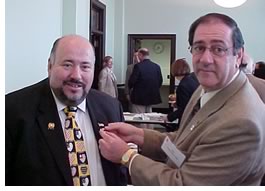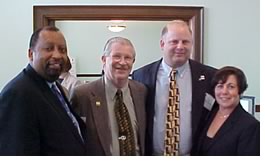
Legislative Day discussions focus on school construction, smart growth, and legislative process
by Peter C. Lampen, AIA
AIA New Jersey Legislative and Government Affairs Committee
Some 50 AIA New Jersey members convened at their Statehouse Annex October 7 to take part in the AIA NJ Legislative Day. Boards displaying members' work graced the meeting room as well as the tunnel linking the Statehouse and the Annex, where they were viewed by hundreds of legislators and staff and members of the public. Three panel discussions covered topics of immediate concern to all architects and allowed us to meet and hear the views of legislators, state agencies, and advisors to the governor.
School construction program
The first panel discussed the status of the state school construction
program. Moderator Eric Wagner, AIA, welcomed Mark Lohbauer, director
of policy for the New Jersey Schools Construction Corp.; Bernie Piaia
of the N.J. Department of Energy; and Assemblyman Joe Doria to the panel.
 Lohbauer
discussed the creation of the Schools Construction Corp. within the N.J.
Economic Development Authority (EDA) and efforts to bring on the professionals
needed to get the program up and running. New schools built under the
program will have to comply with the most basic level of U.S.
Council of Green Building's Leadership in Energy and Environmental Design
(LEED™) certification, be designed with community involvement,
and be accessible for a number of community purposes. New schools also
must be "designed for learning," that is, incorporate new learning
techniques, layouts, and designs and have the capability to employ advanced
technologies.
Lohbauer
discussed the creation of the Schools Construction Corp. within the N.J.
Economic Development Authority (EDA) and efforts to bring on the professionals
needed to get the program up and running. New schools built under the
program will have to comply with the most basic level of U.S.
Council of Green Building's Leadership in Energy and Environmental Design
(LEED™) certification, be designed with community involvement,
and be accessible for a number of community purposes. New schools also
must be "designed for learning," that is, incorporate new learning
techniques, layouts, and designs and have the capability to employ advanced
technologies.
Doria discussed the program's history, pointing out that it has survived court challenges to the revenue source from revenue bonds. The EDA is now ready to move forward on projects for the Abbott school districts, he said. Doria also noted that architects have an opportunity to work with school districts to create the five-year facility plans required of every district seeking funding and collaborate on the required annual updates. Under these plans, the state will encourage the school boards to maximize community uses for the buildings and extend hours of operation to 7 days a week/18 hours a day. This will require that the school boards work with their local governments to arrange for the cooperative funding and staffing needed, for example, to incorporate a public library into a school.
Smart growth and livable communities
The second panel—Moderator Jim Gatsch, FAIA; Marty Bierbaum, Governor's
Policy Office for Smart Growth; Adam Zellner, executive director, New
Jersey Office of Smart Growth; Senator John Adler; and Senator Leonard
Lance—focused on Smart Growth and Livable Communities. Gatsch opened
the discussion by declaring that smart growth is basically good design
that creates identity of place. It has multifunctional civic buildings
at the center of the community and a variety of housing types for various
income levels, promotes mixed-use structures, makes open space readily
available, offers a variety of transit options, and leaves a sustainable
legacy.
 Lance
described the legislature's struggle to continue funding open-space preservation.
He cited the conflict of "enhancing revenues" for this purpose
with the great need to reform property tax policy, which he described
as the "engine driving population to the lower-taxed outer suburbs
and rural areas." Adler then described the problems of New Jersey's
older urban areas, using Camden in his district as an example. He discussed
the initiatives necessary to make older cities desirable living places
again, pointing out how this process is crucial to statewide smart growth,
especially in keeping sprawl from spreading out continually.
Lance
described the legislature's struggle to continue funding open-space preservation.
He cited the conflict of "enhancing revenues" for this purpose
with the great need to reform property tax policy, which he described
as the "engine driving population to the lower-taxed outer suburbs
and rural areas." Adler then described the problems of New Jersey's
older urban areas, using Camden in his district as an example. He discussed
the initiatives necessary to make older cities desirable living places
again, pointing out how this process is crucial to statewide smart growth,
especially in keeping sprawl from spreading out continually.
Bierbaum discussed some of the principles of smart growth, which he equated to good government. Sprawl penalizes us by taking time away from our families and our communities, he said. Bierbaum defined smart growth by mixed uses, compactness of design, preservation of open and farm land, walkable communities, multimodal transport, variety of housing choices, community stakeholders, and infrastructure investments. He told the group that the Smart Growth Policy Council has met 10 times, and has defined its mission based on the governor's priorities: Urban revitalization, protection of open space and water resources, interagency cooperation in use and distribution of data, and the agencies' communication of coherent smart-growth policy. All new state rules and regulations are required to have a Smart Growth Impact Statement reviewed before adoption and implementation, Bierbaum said.
Zellner stated that based on the 2000 census, New Jersey will become the first state in the nation to be completely "built-out" by 2020. The Office of Smart Growth will focus on bringing services to municipalities with teams that will assist counties with state agency reviews of master plans, circulation plans, and open-space plans and create incentives for counties to comply with the state plan.
 The
legislative process
The
legislative process
Michael Soriano, AIA, moderated the Legislative Process panel, joined
by Nancy Becker and Tricia Russo, Esq., of Nancy Becker Associates; Hal
Lichtman, AIA, for NJAPAC, the state chapter's political action committee;
and Assemblyman David Wolfe. Wolfe described the flood of bills each legislator
must handle and said how much he valued informed lobbyists to help him
in is duties. Russo described the path a bill takes from initial submission
through committee assignment, mark-up and amendment, voting-out to the
floor, passage by both houses, and finally gubernatorial signature, veto,
or conditional veto.
Becker then described the lobbying process, the knowledge of the issues and its opponents required for successful passage of legislation, and the pitfalls that may befall even the best-laid plans. She used the interior designers' bill as an example of much hard work by architects and her office that still failed to produce the desired result. She urged all AIA New Jersey members to write the governor and request conditional veto of the language we object to most.
AIA New Jersey's legislative day ended with a tour of the Statehouse, led by Anne Weber, AIA, project manager for Ford Farewell Mills & Gatsch, architect of the Statehouse restoration project.
Copyright 2002 The American Institute of Architects. All rights reserved.
![]()
|
Peter Lampen is a member of AIA New Jersey's Legislative and Government Affairs Committee and of Ford Farewell Mills & Gatsch. A Guide to Legislative Lobbying at Grassroots 2002 or Closer to Home |
|